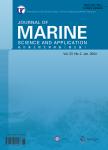雷州半岛玄武岩岩石学、水化学及其对CO2矿化模拟的影响(英文)
作者机构:Key Laboratory of Ocean and Marginal Sea Geology South China Sea Institute of Oceanology Chinese Academy of Sciences University of Chinese Academy of Sciences UK-China (Guangdong) CCUS Centre University College London
出 版 物:《Journal of Marine Science and Application》 (哈尔滨工程大学学报(英文版))
年 卷 期:2024年第3期
页 面:583-598页
核心收录:
学科分类:083002[工学-环境工程] 0830[工学-环境科学与工程(可授工学、理学、农学学位)] 0709[理学-地质学] 070901[理学-矿物学、岩石学、矿床学] 07[理学] 08[工学]
基 金:funded by the National Natural Science Foundation of China (U1901217) Guangdong Basic and Applied Basic Research Foundation (2021A1515011298) the National Key R&D Program of China (2021YFF0501202) Special Fund of South China Sea Institute of Oceanology of the Chinese Academy of Sciences (SCSIO2023QY06)
摘 要:Mineral carbonation, which precipitates dissolved carbon dioxide(CO2) as carbonate minerals in basaltic groundwater environments, is a potential technique for negative emissions. The Leizhou Peninsula in southwest Guangdong province has extensive basalt, indicating a promising potential for CO2storage through rapid mineralization. However, understanding of the basic geological setting, potential, and mechanisms of CO2mineralization in the basalts of the Leizhou Peninsula is still limited. The mineralization processes associated with CO2storage at two candidate sites in the area are investigated in this paper: Yongshi Farm and Tianyang Basin(of the dried maar lake). Petrography,rock geochemistry, basalt petrophysical properties, and groundwater hydrochemistry analyses are included in the study. Numerical simulation is used to examine the reaction process and its effects. The results show that basalts in the study areas mainly comprise plagioclase, pyroxene, and Fe–Ti oxides, revealing a total volume fraction exceeding 85%. Additionally, small amounts of quartz and fayalite are available, with volume fractions of 5.1% and 1.0%, respectively. The basalts are rich in divalent metal cations, which can form carbonate minerals, with an average of approximately 6.2 moles of metal cations per 1 kg of rock. The groundwater samples have a pH of 7.5–8.2 and are dominated by the Mg–Ca–HCO3 type. The basalts demonstrate a porosity range of 10.9% to 28.8%, with over 70% of interconnected pores. A 20-year geochemical simulation revealed that CO2injection dissolves primary minerals, including anorthite, albite, and diopside, while CO2mineralization dissolves precipitation secondary minerals, such as calcite, siderite, and dolomite. Furthermore, a substantial rise in pH from 7.6to 10.6 is observed in the vicinity of the injected well, accompanied by a slight reduction in porosity from 20% to 19.8%. Additionally, 36.8% of the injected CO2underwent complete mineralization within five y



